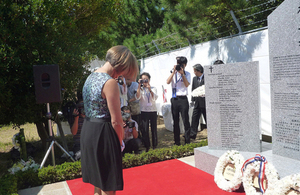Allied POW memorial unveiled in western Japan
British Embassy Minister attends unveiling ceremony at reconciliation event in Nagasaki

Julia Longbottom, Minister at the British Embassy Tokyo, laid a wreath at the memorial.
On Sunday 13 September, Julia Longbottom, Minister at the British Embassy Tokyo, represented the British government at a ceremony at Koyagijima Junior High School near Nagasaki, where a memorial was unveiled in honour of Dutch, British, Australian and American prisoners of war (POWs) who died at the Fukuoka No 2 Camp that occupied the site from October 1942 until 13 September 1945.
Thanks to the efforts of volunteers staff of the POW Research Committee Japan, the ceremony was attended by family representatives of 3 British POWs, as well as 18 Dutch citizens affected directly or indirectly by the Camp.
Among them was one British former POW who was interred in Java, Indonesia with her Dutch mother and two siblings for 3 years at the end of the war. Her father had been brought to Japan and held at the Fukuoka No 2 Camp in Nagasaki.
A Dutch POW, himself interred at the Fukuoka No 2 Camp aged 17, was one of those who made the journey to Japan with his family to attend the event.
Alongside a memorial recording the names of the 41 Dutch, 21 British, 6 Australian and 5 US nationals who died at the Camp, a second memorial has been added to commemorate the lives of the 13 US airmen who died on 4September 1945 when their B-29 delivering emergency rations to the released POWs crashed into a nearby hillside. The family of the only survivor travelled from the US to attend the event.
Speaking to the Japanese organisers, local representatives and visiting families after the ceremony, Julia Longbottom said:
Today’s ceremony is a moment to remember the fortitude and endurance of the Nagasaki Prisoners of War; as well as to celebrate the generosity of spirit that has made today’s act of reconciliation so moving and meaningful.
She also thanked the Memorial Building Committee and the POW Research Network Japan members for their determined work to establish the memorial and to contact the survivors’ families.
The volunteers’ arrangements for the visit to Japan and for the ceremony provided a moving opportunity for the visiting POWs and their families to share their stories, but also to hear the stories of local Japanese people. As one British visitor said,
I now understand that we are all survivors.
Speaking after the event, Julia Longbottom said:
It’s a fantastic example of the impact that Japanese volunteers and civil society can have. All those who visited were deeply touched by the humanity and the warmth of their Japanese hosts. One visitor told me that coming to Japan for this event had ‘changed everything’. I found it an important reminder of the power of sharing information, and forging human relationships to achieve reconciliation.
About the Nagasaki memorial
20 years ago a British author contacted one of the surviving POWs for material for a novel he was writing. He travelled to Nagasaki to search for the site of the Fukuoka No 2 camp on Koyagijima. A local taxi driver helped him find both the junior high school now on the site and the family of a Japanese prison guard. Together they decided that something must be done to mark the site. After fruitless efforts over many years, the taxi driver secured the help of a Nagasaki City Counsellor, who helped bring the project to fruition by forming a committee with other private individuals and raising money among the city’s inhabitants.